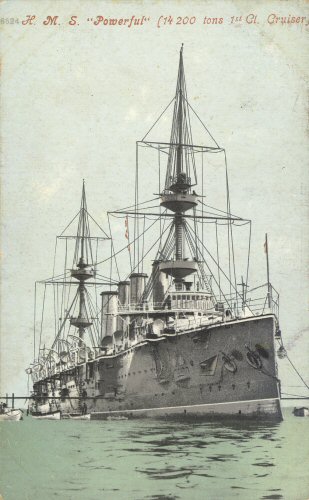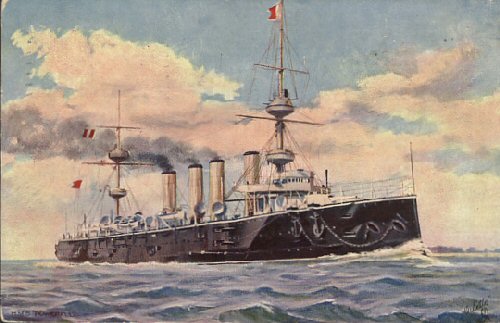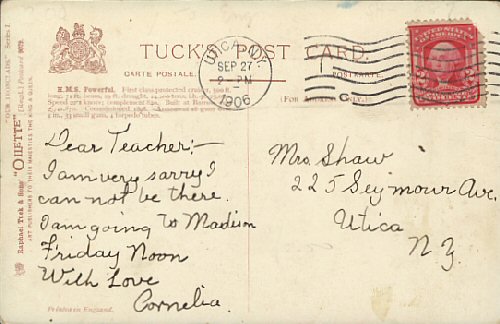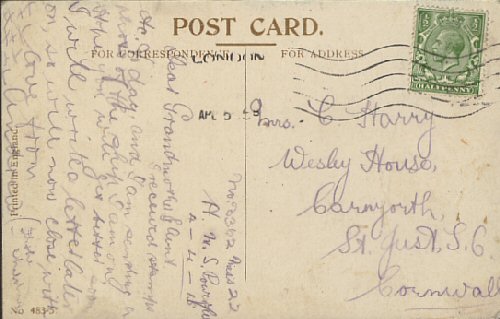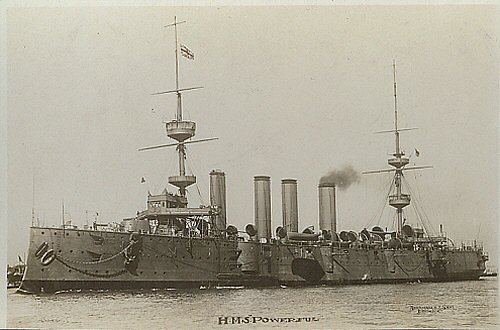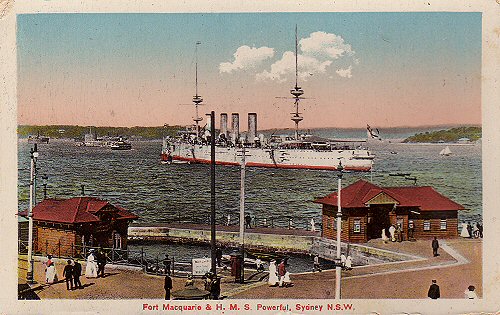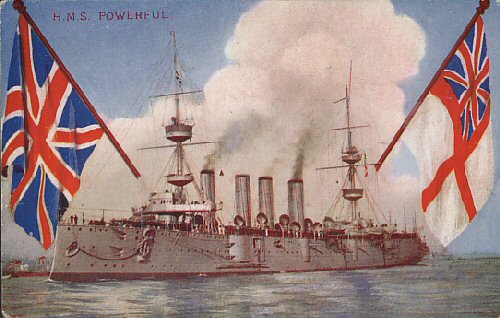
Sold for Scrap 1929
SPECIFICATIONS
Displacement - 14,200tons
Dimensions - 538x71x27ft
Machinery - 2-shaft, 4 cyl TE, 48 Belleville boilers, 25,000ihp. Coal 3000t
Armour - Deck 6in-2in, barbettes, turrets 6in, ammunition hoists 2in, casemates 6in-2in, CT 12in
Armament - 2-9.2in, 12-6in QF, 16-12pdr QF, 12-3pdr QF, 4-18in TT sub
Complement - 894
Launched - 8.6.1897
Builder - Vickers, Barrow
Fate - sold 1929
HMS Powerful and her sister ship HMS Terrible were the largest cruisers in the world during the 1890's. The Powerful was built by the Naval Construction and Armaments Company in Barrow-in-Furness and launched on the 24th July 1895. HMS Powerful was built to compete against the New Russian Cruisers Rurik and Rossiya; these two Russian ships were the largest and longest warships built at the time. HMS Powerful and HMS Terrible were very expensive to build, costing twice the cost of the Edger class, built two to three years earlier. HMS Powerful started service in the China Station and in 1899 became famous for landing naval brigades (along with HMS Terrible) at the cape to take part in the relief of Ladysmith during the Boer War. She went into refit in 1902 until 1904 when she went into the reserve fleet. She was used for harbour service in 1912 and from 1915 she was used as a training ship until the late 1920's, and she was renamed HMS Impregnable II in 1919. She was finally scrapped in 1929.
"During World War I, the naval brigade idea of using naval personnel to fight ashore was used for naval reservists and the Royal Naval Division was formed to assist the army in various theatres of war. The RND was disbanded in 1920.
The most famous action in which the Naval Brigades were involved - which was commemorated by the Field Gun Run at the Royal Tournament - is that of the relief of Ladysmith during the Boer War. In October 1899, British Army chiefs were out gunned by Boer troops who were threatening the garrison at Ladysmith. An appeal was sent to the Royal Navy for guns as a last resort. How could the Navy, hundreds of miles away at their base at Simonstown, send artillery over land in time to stop the Boer attack? Rear Admiral Sir Robert Harris mounted a plan to strip guns from HMSs Terrible and Powerful and take them over land to Ladysmith. The guns, on mountings designed by Captain Percy Scott of HMS Terrible, had to be taken 800 miles by sea, from Simonstown to Durban, and from there on a 190 mile haul to Ladysmith.
Within 24 hours, Captain Lambton, of HMS Powerful, had loaded three 12 pounder guns and the two 4.7” guns on board and was steaming flat out to Durban, where two special trains were waiting to carry the men and guns to Ladysmith. The trains travelled through the night to get to Ladysmith, before the Boers could close off the town and destroy the railway line. The guns were unloaded amongst rifle fire and a deluge of shells from the Boers. In the midst of the fighting, the naval brigade assisted by a team of oxen, hauled their guns from the station, across rocky terrain and into position where they could be brought to bear on the Boers’ heavy gun emplacements.
Meanwhile, a second naval brigade brought more naval guns to join a relief infantry force, under the command of General Sir Redvers Buller. After four months, Ladysmith was relieved on the 1st March 1900, after Buller had broken through under a barrage laid down by naval gunners to cover his advancing infantry.
Lambton brought HMS Powerful home to an unprecedented welcome. His crew pulled their guns through the street of Portsmouth and London as crowds cheered, sang and waved Union Jacks." - Royal Naval Museum Library Information leaflet.
